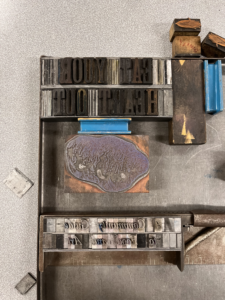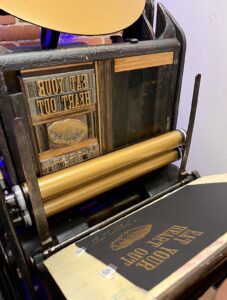For Olivia Olson-Roberts ‘25, zines are a way of life. Originally from Portland, Oregon, they were surrounded by zine culture growing up and were always inspired by that punk ethos. But it was only during their Fall 2023 co-op at Gallery360 that zines became professionally relevant.
Working at Gallery360 is a dynamic experience; no two days are the same. One day could call for a deep-dive of research on the computer, and another might be totally hands-on in the gallery. As an art history and visual art combined major, Olivia was thrilled by that level of variety.
When the time came for them to develop an independent project born out of Center for the Arts and Gallery 360 activities, it was a no-brainer. With a collaborative zine project, Olivia combined their longtime passion for DIY publications with their newfound skills in curatorial writing.
Zines as curatorial work
It all started with a still life. At the Portland Art Museum one summer, Olivia was struck by a series of still life paintings. They were blown away by the thought and care that went into these images. By some strange coincidence, after leaving the museum, Olivia came across a bunch of grapes and strawberries that had fallen onto the ground; what was once a thoughtfully prepared meal had suddenly gone to waste. Moved by the contrast between the paintings and the dropped fruit, Olivia was inspired to create a publication dedicated to food –– aptly titled Eat Your Heart Out.
Olivia collected student submissions through an open call––gathering poems, stories, and drawings from Northeastern students about what food means to them. The pieces include wide-ranging works, from a personal anecdote about lobster fishing and a poem about pomegranates, to an old family recipe for lemon loaf. Olivia carefully laid these all out in InDesign, sprinkling their own drawings throughout; next came the time to write an introduction.
After writing exhibition labels during their co-op, Olivia was prepared to analyze specific artworks, in this case ones such as Felix González-Torres’ 1991 Untitled (Portrait of Ross in L.A.). But rather than making an academic argument, the piece’s main purpose was to introduce and frame the student submissions anecdotally––a new challenge.
“I feel confident in my ability to write an academic art history paper,” Olivia said, “but incorporating my own experience into a piece of writing was new for me.” Olivia’s supervisor, Center for the Arts Director Juliana Barton, helped them think about how to complement the art historical analysis with an engaging personal narrative.
Going through the editing process was a major learning experience. “Whether it’s stuff that I wrote for the wall labels in the gallery, or something like this,” Olivia said, “striking this balance between academic and approachable writing about art is so interesting.”
“Curatorial writing requires a delicate balance of exposition and interpretation,” Barton added. “Weaving personal narrative into such writing reminds the reader that there’s a real human behind the words.”
Collaborating with Huskiana
Next, it was time to print. Given Olivia’s art-making background and interest in the handmade, Barton recommended that they print the covers at Huskiana, Northeastern’s letterpress studio.
Nestled in Holmes hall, Huskiana is a hidden gem on campus run by History professor Jessica Linker and English faculty member Isabel Sobral Campos. The two of them are the driving force behind the press, stocking the collection with various materials and instructing community members on how to use the machine.


Huskiana’s selection of metal letters. Image: Olivia Olson-Roberts.
“The thing that’s been really cool about this process,” Olivia said, “is that I’ve been able to work with Jessica and Isabel every step of the way.”
Huskiana has an impressive collection of letters—over a dozen fonts—that Olivia laid out on a track for the cover. Then, they added small wooden or metal blocks, called “furniture,” which surround the base and hold the design in place. The blocks are “not quite perfect,” Olivia said, which gives them that handmade, quirky look.
Even just the process of laying out the letters took over two hours. “You don’t realize how time consuming it is,” Olivia said. While sifting through the dozens of fonts at Huskiana, they gained a new appreciation for the time and care that goes into DIY publishing.


Once everything was laid out, Olivia printed 100 copies. The letter press is powered manually. It has a big ink pad and a large wheel that Olivia had to put their whole body into to turn––another time-consuming part of the process. Finally, Olivia hand-bound the zines herself, punching holes in the sheets with a pin and stringing embroidery floss through them.

Olivia even hand-numbered the pages. Eat Your Heart Out was a limited-run publication, so the 100 copies are going to her friends and family, as well as to everyone who helped with the zine –– including students, CAMD faculty, and the Center for the Arts staff.
Takeaways
In a co-op that’s largely centered on curatorial work, learning the analog techniques of printmaking was a welcome break from the computer screen.
“Printing the covers was probably my favorite part of the process,” said Olivia. “I’m also an artist, and I have my studio practice. So to actually be able to create something tangible with my hands that I can touch and feel has been so rewarding.”
Center for the Arts Director Juliana Barton always likes to make sure that co-ops have an independent project during their six months. For Barton, independent projects are a crucial part of the working world, and a great way to learn skills like time management and creating a project schedule.
Olivia liked working with Huskiana so much that after wrapping up their co-op at Gallery360, they joined the press in the spring as a part-time staff member. In that role, they’ll be paying it forward, helping other people use Huskiana’s resources and bring their own creative projects to life.
More than an independent project, Eat Your Heart Out was an opportunity to enjoy one of the most exciting aspects of curatorial work: bringing people together.
“It was great just seeing that people are interested in small batch publications,” Olivia said, “and about writing these personal stories and finding community in these funny, weird ways.”
“Especially in the age of social media, having something physical is so powerful. These things are really gonna have a life of their own, and there’s only going to be 100 of them. So that makes them really special.”


